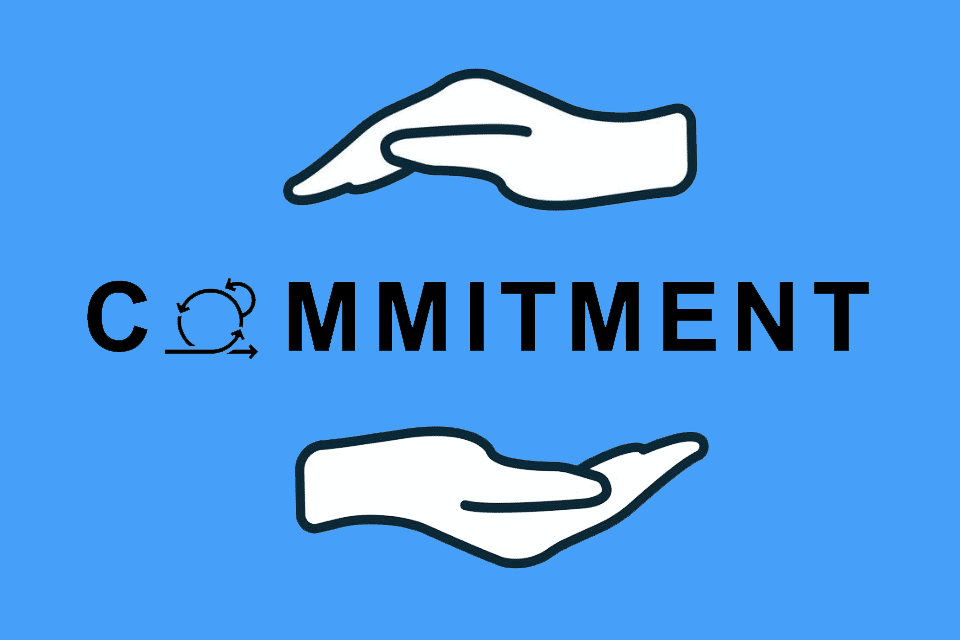What is Commitment?
Commitment – a term with different meanings
Commitment is a term with various meanings:
- Originating from Latin, it stands for entrust or surrender.
- Derived from English, it stands for, among other things, dedication, obligation, binding, promise, submission, determination, assignment, etc.
- In the business context, it is understood as the degree of identification that employees have with their organisation (sometimes also referred to as organisational commitment).
- In the sense of a declaration of responsibility, it is either an expression of organisations to follow laws, rules and guidelines, to respect demands and to keep agreements with other organisations. Or an assurance to pay for the living expenses of a third-country national as a prerequisite for the issuance of a visa or residence permit.
- In terms of a cognitive bias, it refers to the tendency to feel committed to a decision made earlier, even if that decision turns out to be wrong or at least less than ideal (sometimes called escalating commitment).
And commitment is also of central importance in Scrum, the well-known and frequently used framework for the development of complex products and services.
Commitment in Scrum
The Scrum Guide defines courage, openness, focus, respect and commitment as five values that are important ingredients both for solving complex problems and for building high-performing teams. Scrum is based on empiricism (knowledge comes from experience and decision-making is based on observation) and the commitment and self-commitment of those involved promotes this empiricism. Among other things, the Scrum team commits itself to do its best to achieve its jointly defined goals. The team members support each other and agree to continuously improve the cooperation based on feedback and new insights. And the members also put collaborative teamwork in the foreground, which ideally strengthens the trust between everyone involved and helps with qualitative problem solving.
- For example, the Product Owner commits to developing and explicitly communicating the product goal, supported by the Scrum Master in finding techniques to define it effectively. Furthermore, he tries to make the best decisions to optimise the value of the product, even knowing that he probably cannot please all stakeholders.
- The Scrum Master shows dedication by removing obstacles that the Scrum Team cannot solve themselves, rather than tolerating the status quo in the organisation. He also commits to addressing unproductive behaviour or offering appropriate feedback, among other things.
- The developers show engagement by producing an increment that meets their Definition of Done rather than something that is almost done. Delivering the finished increment at the end of the sprint promotes commitment to quality and continuous improvement.
The current Scrum Guide emphasises the importance of commitments in the course of artefacts, with the aim of increasing transparency, improving focus and making progress measurable. Broken down concretely to the individual Scrum Artefacts, there are three direct assignments:
- For the Product Backlog, it is the Product Goal. Product Goals are qualitative objectives of product development, i.e. they determine, among other things, the type and quality of products.
- For the Sprint Backlog it is the Sprint Goal. A Sprint Goal describes the Scrum Team’s vision for a Sprint. It defines the purpose of the Sprint and is the basis for the selection of Backlog Items.
- For the increment, it is the Definition of Done. The Definition of Done is a checklist with quality criteria that defines which tasks are to be completed for Backlog Items.
And of course, the commitment is also reflected in the Scrum Events:
- The Daily Scrum is a good opportunity for the developers to show their commitment to each other and to adjust the plan to achieve the Sprint Goal.
- The Retrospective promotes engagement in continuous improvement within the team by discussing processes, tools and interactions and initiating actionable improvements.
- …
Tips for dealing with commitment
Lack of trust, fear of conflict, lack of commitment, rejection of responsibility and insufficient focus on results are considered the five dysfunctions of teams.¹ And it is not uncommon for a lack of support – aka commitment – to be cited by executives or managers as a major reason for failed projects. At the same time, however, it can be observed time and again how the term is overloaded, so that it makes sense to create a common understanding within organisations when using the term. This understanding is the basis for a common “we-feeling” and for the path towards an agreed goal.
Since engagement and commitment cannot simply be ordered, here are some tips on dealing with them:
- There is always resistance, concern or at least dissent in projects. Do not play down concerns or look for quick answers.
- Do not interpret jointly defined goals as a guarantee or promise, because despite dedication and effort, not all goals will always be achievable. Don’t think of the Sprint Backlog as a commitment to deliver. The moment you start to see defined scopes as promises, you limit your ability to react to changes and new insights. You may even start planning in more detail to gain maximum certainty, but in doing so you negate Scrum’s approach as a framework for dealing with complexity and unpredictability.
- Pay attention to safety nets and make engagement less dangerous. And don’t abuse concepts or events such as velocity, the Daily Scrum or the Sprint Review; velocity is a tool for planning sprints, but not a measure for increasing speed. The Daily Scrum is an exchange for synchronisation and not an accountability report. And the Sprint Review is a meeting to present development results and determine future adjustments, it is not a release event.
- Create a trusting, open working atmosphere and encourage interaction and communication among each other. Do not judge those involved or those not present.
- Be mindful of the Vegas Rule in the course of collaboration and communication. “What happens in Vegas, stays in Vegas”. In many organisations and situations it is the basis for trust. Without trust, the basis for communication and therefore commitment is disturbed.
- Address problems when they are small. Open, honest feedback and the removal of obstacles are important for good cooperation and commitments.
- Make commitments yourself. And, if needed, show that it is okay to make smaller obligations first before agreeing to large ones.
And last but not least: Keep the big picture in mind. Communicate this again and again. And share success stories, as this can ensure commitment to future successes.
As long as people cannot control their own workload, they cannot make commitments.
Notes:
[1] Patrick M. Lencioni: Overcoming The Five Disfunctions of a Team
Here you can find more information about the Scrum Guide.
Here is an assessment of why teams should commit to the Sprint Goal rather than the Sprint Backlog.
If you like the article or would like to discuss it, please feel free to share it in your network. And if you have any comments, please do not hesitate to send us a message.
And here you will find additional information from our t2informatik Blog:




